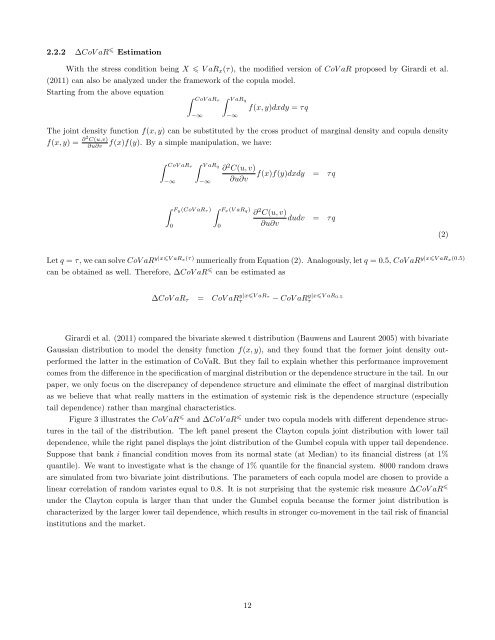Does Tail Dependence Make A Difference In the ... - Boston College
Does Tail Dependence Make A Difference In the ... - Boston College
Does Tail Dependence Make A Difference In the ... - Boston College
Create successful ePaper yourself
Turn your PDF publications into a flip-book with our unique Google optimized e-Paper software.
2.2.2 ∆CoV aR Estimation<br />
With <strong>the</strong> stress condition being X V aR x (τ), <strong>the</strong> modified version of CoV aR proposed by Girardi et al.<br />
(2011) can also be analyzed under <strong>the</strong> framework of <strong>the</strong> copula model.<br />
Starting from <strong>the</strong> above equation<br />
∫ CoV aRτ ∫ V aRq<br />
−∞<br />
−∞<br />
f(x, y)dxdy = τq<br />
The joint density function f(x, y) can be substituted by <strong>the</strong> cross product of marginal density and copula density<br />
f(x, y) = ∂2 C(u,v)<br />
∂u∂v<br />
f(x)f(y). By a simple manipulation, we have:<br />
∫ CoV aRτ ∫ V aRq<br />
−∞ −∞<br />
∂ 2 C(u, v)<br />
f(x)f(y)dxdy = τq<br />
∂u∂v<br />
∫ Fy(CoV aR τ ) ∫ Fx(V aR q)<br />
0<br />
0<br />
∂ 2 C(u, v)<br />
dudv = τq<br />
∂u∂v<br />
(2)<br />
Let q = τ, we can solve CoV aR y|xV aRx(τ) y|xV aRx(0.5)<br />
numerically from Equation (2). Analogously, let q = 0.5, CoV aR<br />
can be obtained as well. Therefore, ∆CoV aR can be estimated as<br />
y|xV aRτ<br />
∆CoV aR τ = CoV aRτ<br />
y|xV aR0.5<br />
− CoV aRτ<br />
Girardi et al. (2011) compared <strong>the</strong> bivariate skewed t distribution (Bauwens and Laurent 2005) with bivariate<br />
Gaussian distribution to model <strong>the</strong> density function f(x, y), and <strong>the</strong>y found that <strong>the</strong> former joint density outperformed<br />
<strong>the</strong> latter in <strong>the</strong> estimation of CoVaR. But <strong>the</strong>y fail to explain whe<strong>the</strong>r this performance improvement<br />
comes from <strong>the</strong> difference in <strong>the</strong> specification of marginal distribution or <strong>the</strong> dependence structure in <strong>the</strong> tail. <strong>In</strong> our<br />
paper, we only focus on <strong>the</strong> discrepancy of dependence structure and eliminate <strong>the</strong> effect of marginal distribution<br />
as we believe that what really matters in <strong>the</strong> estimation of systemic risk is <strong>the</strong> dependence structure (especially<br />
tail dependence) ra<strong>the</strong>r than marginal characteristics.<br />
Figure 3 illustrates <strong>the</strong> CoV aR and ∆CoV aR under two copula models with different dependence structures<br />
in <strong>the</strong> tail of <strong>the</strong> distribution. The left panel present <strong>the</strong> Clayton copula joint distribution with lower tail<br />
dependence, while <strong>the</strong> right panel displays <strong>the</strong> joint distribution of <strong>the</strong> Gumbel copula with upper tail dependence.<br />
Suppose that bank i financial condition moves from its normal state (at Median) to its financial distress (at 1%<br />
quantile). We want to investigate what is <strong>the</strong> change of 1% quantile for <strong>the</strong> financial system. 8000 random draws<br />
are simulated from two bivariate joint distributions. The parameters of each copula model are chosen to provide a<br />
linear correlation of random variates equal to 0.8. It is not surprising that <strong>the</strong> systemic risk measure ∆CoV aR <br />
under <strong>the</strong> Clayton copula is larger than that under <strong>the</strong> Gumbel copula because <strong>the</strong> former joint distribution is<br />
characterized by <strong>the</strong> larger lower tail dependence, which results in stronger co-movement in <strong>the</strong> tail risk of financial<br />
institutions and <strong>the</strong> market.<br />
12
















